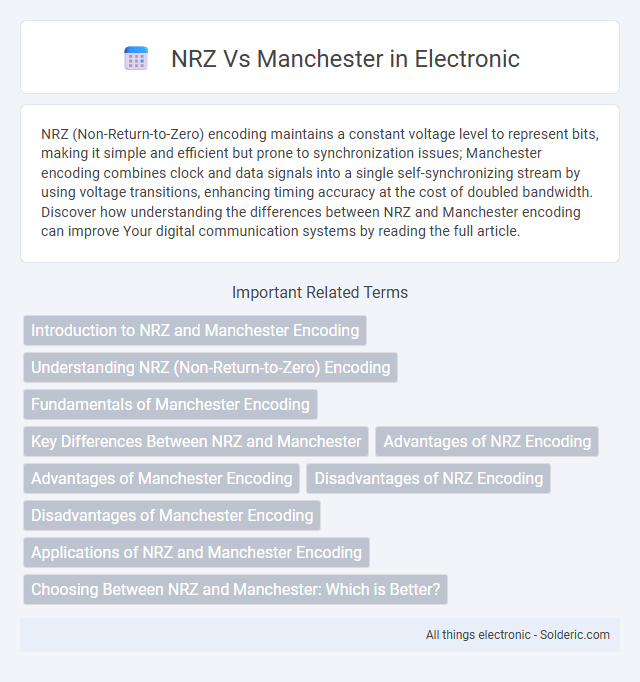NRZ (Non-Return-to-Zero) encoding maintains a constant voltage level to represent bits, making it simple and efficient but prone to synchronization issues; Manchester encoding combines clock and data signals into a single self-synchronizing stream by using voltage transitions, enhancing timing accuracy at the cost of doubled bandwidth. Discover how understanding the differences between NRZ and Manchester encoding can improve Your digital communication systems by reading the full article.
Comparison Table
| Feature | NRZ (Non-Return to Zero) | Manchester Encoding |
|---|---|---|
| Definition | Binary signal where voltage level remains constant during bit interval | Signal where each bit has a transition in the middle for synchronization |
| Signal Levels | Two levels: High or Low representing bits 1 and 0 | Transition-based encoding combining clock and data |
| Synchronization | Low, requires additional clock signal for data recovery | High, self-clocking due to mid-bit transitions |
| Bandwidth Usage | Lower bandwidth compared to Manchester | Consumes double the bandwidth of NRZ |
| DC Component | May have DC component leading to baseline wander | No DC component; zero average voltage |
| Error Detection | No inherent error detection | Improved error detection due to transitions |
| Applications | Simple systems, low bandwidth links | Ethernet (10BASE-T), RFID, and other synchronized communication |
Introduction to NRZ and Manchester Encoding
NRZ (Non-Return-to-Zero) encoding represents binary data using two distinct voltage levels without returning to zero between bits, resulting in simple and efficient signal transmission. Manchester encoding combines clock and data signals by encoding each bit with a transition at the midpoint, ensuring synchronization and reducing timing errors. Both encoding schemes address digital communication challenges, with NRZ offering straightforward implementation and Manchester providing improved clock recovery and error detection.
Understanding NRZ (Non-Return-to-Zero) Encoding
NRZ (Non-Return-to-Zero) encoding represents binary data with two distinct voltage levels without returning to zero between bits, making it efficient for simple, high-speed data transmission. This method reduces bandwidth usage compared to Manchester encoding, which uses voltage transitions to encode data and ensures synchronization but requires more bandwidth. Understanding NRZ helps you choose encoding methods that optimize data rate and channel capacity for your communication systems.
Fundamentals of Manchester Encoding
Manchester encoding combines clock and data signals by representing each bit with a transition: a low-to-high voltage change signifies a binary 0, while a high-to-low transition represents a binary 1. This method ensures synchronization between the sender and receiver, overcoming the synchronization issues common in Non-Return-to-Zero (NRZ) encoding. Manchester encoding doubles the signal bandwidth compared to NRZ but offers better error detection and clock recovery capabilities.
Key Differences Between NRZ and Manchester
NRZ (Non-Return-to-Zero) encoding transmits data using two distinct voltage levels without returning to zero between bits, resulting in a simpler signal with higher bandwidth efficiency. Manchester encoding combines clock and data signals by encoding each bit as a transition, providing inherent synchronization and better error detection at the cost of doubling the required bandwidth. The key differences lie in NRZ's lack of synchronization capability versus Manchester's built-in clock recovery, making NRZ suitable for long-distance transmission with stable clocks and Manchester ideal for environments requiring robust timing and error resilience.
Advantages of NRZ Encoding
NRZ (Non-Return to Zero) encoding offers high bandwidth efficiency by representing data bits directly as voltage levels, eliminating the need for additional transitions and saving transmission time. Its simplicity in implementation reduces hardware complexity and power consumption, making it ideal for long-distance communication where signal integrity and energy use are critical. You benefit from a straightforward encoding scheme that maximizes data throughput while maintaining reliable signal transmission.
Advantages of Manchester Encoding
Manchester encoding offers superior synchronization benefits by embedding clock information within the data signal, reducing timing errors during transmission. Its self-clocking nature enhances data integrity, making it ideal for high-speed communication protocols such as Ethernet. Furthermore, Manchester encoding mitigates baseline wander and DC bias problems, ensuring consistent signal quality across various transmission media.
Disadvantages of NRZ Encoding
NRZ encoding suffers from synchronization issues due to long sequences of identical bits, leading to difficulty in clock recovery. This scheme also lacks a guaranteed signal transition, increasing vulnerability to errors in noisy communication channels. Your data integrity may be compromised without additional mechanisms for error detection and synchronization.
Disadvantages of Manchester Encoding
Manchester encoding increases the required bandwidth due to its signal transitions at every bit interval, resulting in less efficient use of the communication channel compared to NRZ. This encoding method also leads to higher power consumption in digital circuits because of frequent signal changes. Furthermore, Manchester encoding complicates clock recovery and decoding circuitry, making system designs more complex and costly.
Applications of NRZ and Manchester Encoding
NRZ encoding is widely used in high-speed digital communication systems such as USB, Ethernet (10BASE-T), and serial communication protocols due to its simplicity and bandwidth efficiency. Manchester encoding finds applications in RFID systems, IEEE 802.3 Ethernet standards (10BASE5, 10BASE2), and wireless communication where clock recovery and synchronization are critical. Both encoding schemes serve distinct roles based on transmission requirements, with NRZ favored for long-distance and high-throughput data and Manchester suited for error-resistant, synchronized data transfer.
Choosing Between NRZ and Manchester: Which is Better?
NRZ (Non-Return-to-Zero) offers simplicity and higher bandwidth efficiency, making it ideal for long-distance transmission with minimal noise susceptibility. Manchester encoding provides better synchronization and error detection through its embedded clock signals, improving reliability in noisy environments but requiring more bandwidth. The choice depends on application requirements: NRZ suits high-speed, low-noise channels, while Manchester excels where timing accuracy and error resilience are critical.
NRZ vs Manchester Infographic

 solderic.com
solderic.com